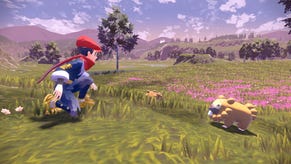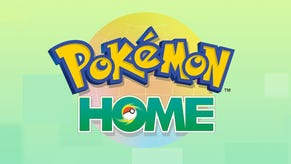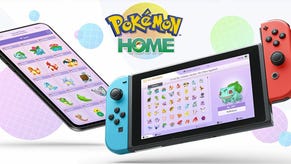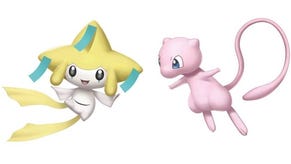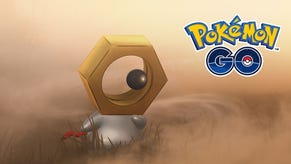Pokémon Let's Go review - an assured balancing act for fans old and new
There and Marowak again.
Over time, Pokémon games have developed themselves a bit of a conundrum. These are family games, bright and inviting and unquestionably filled with joy. Yet a lot of their audience - and I can say this because it includes me - is pushing on a bit. It means that every game kicks off with two opposing impulses, at once trying to welcome a new generation and ease them in gently to the 20-year-old whirlpool of systems and rituals, while also giving those 20-year-long fans something worthwhile, something challenging, and something new.
Pokémon Let's Go, Pikachu! and Let's Go, Eevee! are very obviously designed to solve at least one half of the problem. I suspect Game Freak's ideal outcome is you, the old Pokémon veteran, playing Let's Go in co-op on the sofa alongside your freshly hatched little one, spotting the difference between past and present Kanto like you're driving through an old hometown and telling the kids that, when you were their age, this was all fields. Looking at Let's Go from that perspective - the perspective of the seven-year-old in the back seat, glued to their Nintendo Switch just like you were to that sticky, streetlit Game Boy Colour - it's hard not to fall in love.
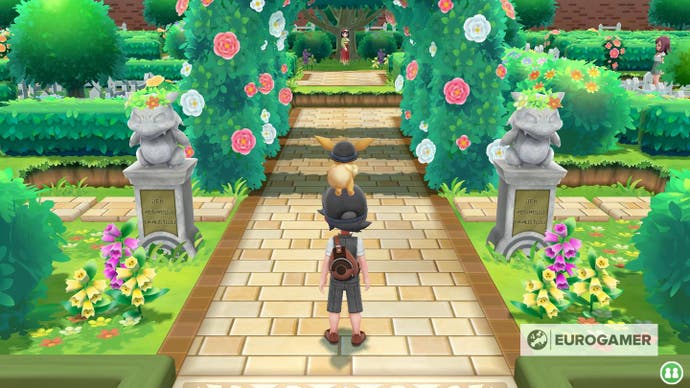
There have been plenty of changes - some more successful than others - but none are bigger or more divisive than the complete retooling of wild Pokémon encounters, one of the three essential ingredients of a main series game, alongside the waning puzzles of the overworld and, of course, the battles.
Thankfully for Let's Go, its biggest shake up is also its best one. Pokémon's old system of battling every wild Pokémon you see - and rummaging around in long grass or muddy caves until you found one at random - seems deeply old-fashioned by comparison. Being able to see the wild Pokémon around you in the overworld, as you can in Let's Go, feels like finally upgrading your phone from the one you got in 2010 and insist is working perfectly fine if you just ignore the crashes and the fact it turns off at around 40 per cent of battery life. Or, to pick a more age-appropriate simile for us geriatric fans, like realising you're not supposed to be squinting at anything further than two inches from your face and finally getting some reading glasses. So this is what it's supposed to be like. Oh yeah!
Catching in Let's Go has its limitations. In docked mode, motion controls are compulsory - I can hear you groaning - and they are definitely motion controls. By which I mean they are quite fun, and surprisingly satisfying with the regular rumbles of the Joy-Con or Poké Ball Plus, but also prone to causing unnecessary and unintentional frustration, the occasional ball throw flailing off wildly to one side, maybe because of something you did or maybe not. While they're also always active in handheld mode, you can use the left stick to aim and mitigate your own shaky-hand movements of the Switch. Hold it perfectly still, or put entire console down, and you can just use the left stick to circumvent motion controls entirely. Either way, it's still a somewhat finickity system, and it's easy to see kids struggling to get to grips with it at first - but then, accompanying seniors can always drop in instantly to help catch in co-op - and it's equally easy to see them master it, like they've apparently mastered your smart phone and tablet and probably advanced coding of some kind while you're still grumbling something about D-pads and achy elbows.

Quirks of motion controls aside, the new catching system actually has plenty to offer for both sets of players. It shifts the emphasis of the games back towards collecting - I'm not ashamed to admit I've let out more than one excited squeal at a surprise rare spawn in an otherwise drab spot just outside town - and it also does something I forgot I needed, which is reintroduce the need for more types of Poké Ball. Players who liked to catch every Pokémon in the base Poké Ball in past games, as a kind of self-inflicted masochism, may well find that unworkable in Let's Go. All wild Pokémon have a chance of fleeing, so you can't sit there throwing low-chance balls at them all day, especially if they're a rare spawn as well.
Likewise, catching has been retooled as a part of training (all catches grant XP to all Pokémon in your party, and it's probably the best way to level up your team too, ahead of battling), meaning that you need to be more strategic about how you use each particular catching item and when. You might want to build up a Catch Combo - a streak of catching the same species several times in a row - to grind XP, Candy, or item rewards. But then you might also want to save your better equipment for catching the rarer Pokémon that spawns after you get that streak successfully.
It's easy to get lost in the weeds regarding what impacts what - this new way of distributing XP makes it easier to level up your team evenly, but much harder to bring one lower-level Pokémon up to speed, for instance - but the end result of the new wild encounters and catching is this: more surprise, more control, more fun, and, above all, it just makes more sense - to be in a mysterious other world, and to actually see and experience the creatures that live there.
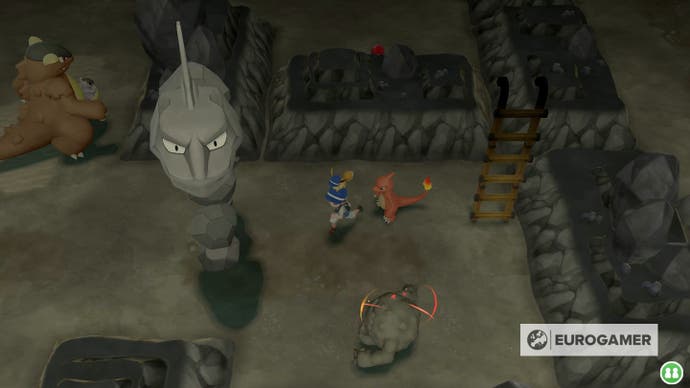
Unlike the catching system, that world itself has remained remarkably unchanged. Barring the slight retooling of a route here or there towards the second half of the game - I have a particularly joyful one in mind that I won't spoil - Kanto has been left pretty much exactly as it was, and I was pleasantly surprised by just how involved it can still be. Pokémon Let's Go's 'dungeons', in their various above- and below-ground forms, are still highly demanding of your concentration and time, especially if you want to uncover all of their secrets without a guide. All the old favourites - warp pads, travellators, boulder puzzles and more - are still present and correct, and still devilishly frustrating if you don't afford them the proper care. Unlike those visible wild Pokémon again, this is something that's already known to be missing from the main series in recent years, even down to the head-scratching approaches to some Gyms. There's an argument to be had over how they affect Let's Go's pacing, especially in the largest, most time-consuming areas of Kanto's admittedly stodgy-slow middle section - but young players won't notice, and old ones will relish the challenge. The return of environmental puzzles is an unequivocally welcome one.
The same, more surprisingly, can be said of Let's Go's old-school approach to battling. Gone are the held items, abilities, Z-moves, and most mega-evolutions, and likewise with just the original, gen-one Pokédex to play with, gone are breeding and most instances of the later-gen Pokémon types and attacks, too. When I say 'surprisingly' I do mean it, because put it like that and it would make sense to not expect Let's Go to work, at least not after the years of accumulative systems and intricacies that are involved in the battle system now.
But it does work, in large part because in moment-to-moment Pokémon, questing across a region to the Pokémon League and whatever lies beyond, many of those systems just don't really come into play - especially not in those gen-one Pokémon that were retrofitted with those abilities and moves after the fact. There's an occasional moment where you remember they're missing - forgetting you can put a Primeape to sleep again, now it's back without it's Vital Spirit, for instance - but they're so few and far between, and those systems were just so rarely necessary in the main story playthrough, that their absence barely registers. If you needed your Pokémon to hold items and rely on abilities in the past, you were probably making mistakes in how you battled anyway.
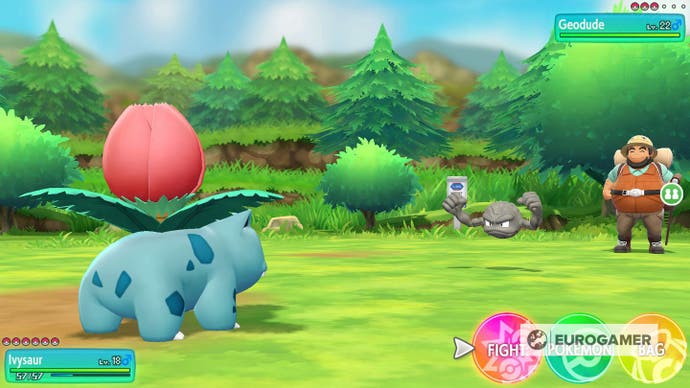
There's always the counter that said abilities, in particular, make certain Pokémon what they are - imagine a Mimikyu without it's Disguise, for instance - but then, the only Pokémon in Let's Go are, again, the first 151. (In other words, their characters were already plenty strong enough, without those added elements needed to enhance them.)
The game undoubtedly has flaws, perhaps the greatest of which, believe it or not, being its choice of art style - smooth and shallow, straight from the incoherent, juxtaposed fashions of Pokémon Go and the awkward world of AR - that sits in painful contrast to the stirring vision of fellow Switch contemporaries like Breath of the Wild. Pokémon Go is wonderful for all sorts of reasons, but it has a remarkable ability to entirely and consistently miss the many finer points of Pokémon itself, one of which being that this is a game built around its art, from its cards, to its anime, to its games, even in the confines of two-colour graphics back in the day. Where necessity bred creativity in the art of Red and Blue, importing Pokémon Go's visual style has the sole effect of stripping Kanto, one of gaming's great worlds, of all its most evocative texture, like someone's blended up your favourite childhood meal and forced you to drink it out of one of those plastic Huel tankards.
Still, important as looks may be to the world of Pokémon, as much as it has its quirks, as much as it can be uneven - how I wish, at times, that it would stop trying to be cute and just let the world do the talking, instead of flying straight past cute and into excessively twee, as it often does - Let's Go has succeeded almost everywhere else. Miraculously, I think it works, for both the little one curled up in that back seat and this big one, who really wishes he didn't have to drive.



